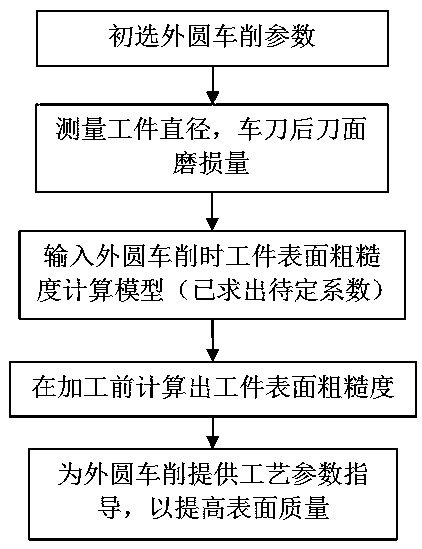Method for calculating workpiece surface roughness during cylindrical turning by considering workpiece vibration
A technology for workpiece surface and external turning, which is used in metal processing machinery parts, manufacturing tools, metal processing equipment, etc., and can solve the problems of complicated measurement and calculation, increase of workpiece surface roughness, and difficulty in predicting and calculating workpiece surface roughness. Achieve the effect of high precision, simple calculation method and improved surface quality
- Summary
- Abstract
- Description
- Claims
- Application Information
AI Technical Summary
Problems solved by technology
Method used
Image
Examples
Embodiment Construction
[0018] Combine below figure 1 figure 2 The present invention is further described in detail.
[0019] In step 1), according to the machine tool-tool-workpiece vibration theory, the impact of the vibration of the workpiece in the direction of cutting depth on the roughness is much greater than the vibration in other directions. For the cylindrical turning of shaft parts, the diameter of the workpiece is taken as a characteristic quantity of the workpiece vibration, and the calculation model of the surface roughness of the workpiece is established based on the turning parameters, workpiece diameter, and tool wear:
[0020] R a =k×a p a × f b ×V c ×D d ×VB e (1)
[0021] Among them, R a is the surface roughness of the workpiece; a p is the amount of back cutting; f is the feed; V is the cutting speed; D is the diameter of the workpiece; VB is the amount of wear on the flank of the turning tool;
[0022] In step 2), with the help of vernier calipers, roughness meter,...
PUM
| Property | Measurement | Unit |
|---|---|---|
| surface roughness | aaaaa | aaaaa |
Abstract
Description
Claims
Application Information
 Login to View More
Login to View More - R&D
- Intellectual Property
- Life Sciences
- Materials
- Tech Scout
- Unparalleled Data Quality
- Higher Quality Content
- 60% Fewer Hallucinations
Browse by: Latest US Patents, China's latest patents, Technical Efficacy Thesaurus, Application Domain, Technology Topic, Popular Technical Reports.
© 2025 PatSnap. All rights reserved.Legal|Privacy policy|Modern Slavery Act Transparency Statement|Sitemap|About US| Contact US: help@patsnap.com



